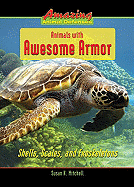 Female giant wood spider hanging from web as the exoskeleton splits along the edges of the cephlothorax. |
 The old covering over the abdomen tears apart and away as the spider pulls its legs free. |
 The spider carefully pulls her long fragile legs free of the old skin. If something goes awry the spider could end up without its legs. |
 Upon freeing itself the giant wood spider dangles helplessly from the old exoskeleton as blood pumps and expands the new exoskeleton while it is still soft. The spider cannot return to its web for about 20 minutes, or long enough for the the exoskeleton to dry and harden. [Footnote on Image & Credit] |
Pronunciation key ( ek′sō-skel′ə-tʼn ) |
ex•o•skel•e•ton
n.
Zoology, Biology. Bony or horned external protective covering, armor especially in many invertebrates such as insects or crustaceans. A hardened integument or shell such as of those of crustaceans, the scales and plates of fishes. An external skeleton or supporting structure such as a shell of an oyster, lobster, crab that protects soft tissues and organs of invertebrates (the lower animals) and is derived from the ectoderm. Exoskeletons are found only on lower animals. The best examples are shells of crustaceans or the protective shell of the turtle. Muscles and organ systems lie within the exoskeleton, unlike vertebrates where the muscles and organs surround most of the supportive skeleton. Dermoskeleton.
Anatomy. In vertebrates the term is sometimes applied to structures produced by the epidermis such as hair, nails, hoofs, teeth and so forth. Compare with endoskeleton.
Exoskeleton in the Crayfish
The exoskeleton is composed mainly of protein and a hard substance called chitin. In some crustaceans like the crayfish, the exoskeleton also contains calcium salts which make it especially durable. The exoskeleton is secreted by cells of a thin underlying layer called the epidermis. The exoskeleton consists of two regions. The front or anterior portion the exoskeleton is an unjointed, thick calcareous shell called the carapace. The section of the carapace toward the front between the two eyestalks is called the rostrum.
In the posterior the exoskeleton forms a series of six rings which are connected with each other at joints. Around the joints, the shell is flexible and thin.
Exoskeleton in the Millipede
The exoskeleton is made of chitin and may be hardened due to various calcium salts. The exoskeleton contains tiny canals that are outlets of glands or contain the extensions of sensory cells. The surface of the exoskeleton is covered with hairs, bristles, spines, ribs, granules and ridges of various forms. Some of these appendages such as the trichomes of the Pselaphognatha, are mobile.
ex′o•skel′e•tal adj.
See also Arthropod; Butterfly (Mature); Crustacean.
References
Additional References
Other great books on exoskeletons...

|
by Susan K Mitchell 
|

No comments:
Post a Comment